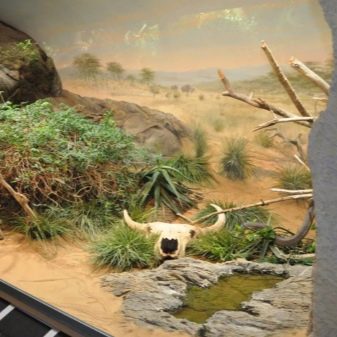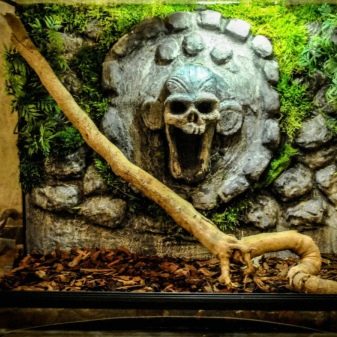All about terrariums for the bearded agama
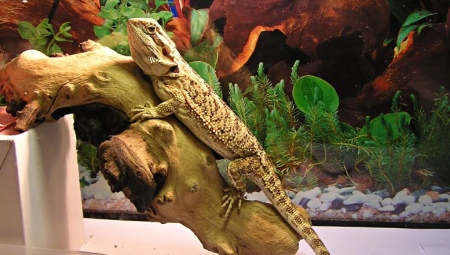
The Australian bearded agama is an exotic animal for our places. Despite this, the popularity of keeping such miniature dragons at home is growing at a record pace. Experienced reptile lovers focus on the good adaptation of lizards to life in captivity. At the same time, beginners are strongly encouraged to learn everything about choosing and equipping terrariums for agama in order to create the most comfortable conditions.
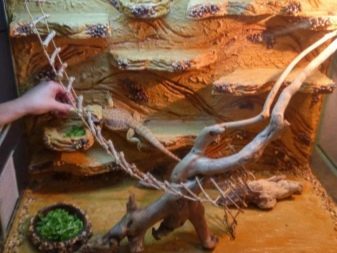
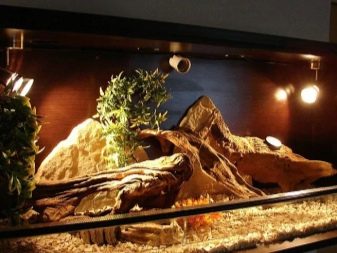
Views
Keeping the described animals in apartments is not associated with any large-scale difficulties. However, it is important to remember that the well-being and life span of a reptile will directly depend on how well the conditions are created for it. And we are talking, first of all, about choosing a terrarium for a bearded agama.
At the moment, there are several varieties of the structures under consideration:
- vertical - Models focused on reptiles who prefer to walk in trees;
- horizontal - structures that will be relevant for land snakes and most lizards, including the described bearded agama;
- cubic - universal terrariums for reptiles, which are equally suitable for animals moving in their natural habitat both on vertical and horizontal surfaces.
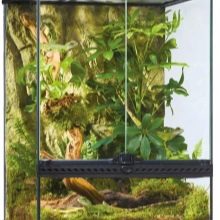
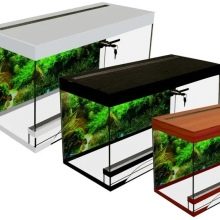
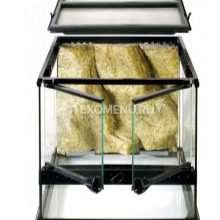
Dimensions (edit)
It is worth noting that the agama is far from the smallest lizard. Adults often grow up to 60 cm. This is what must be taken into account when choosing a specific size terrarium model. An equally important factor is the increased activity of the reptile, which determines the need for sufficient free space.
As a result, practice has proven that the minimum length and width of a dwelling for a bearded agama should be 0.9 and 0.45 m, respectively. If the design of the terrarium provides for the presence of a cover, then its height will not play a decisive role. When choosing a house for two tenants, its length and width will be from 1.2 and 0.55 m, respectively.
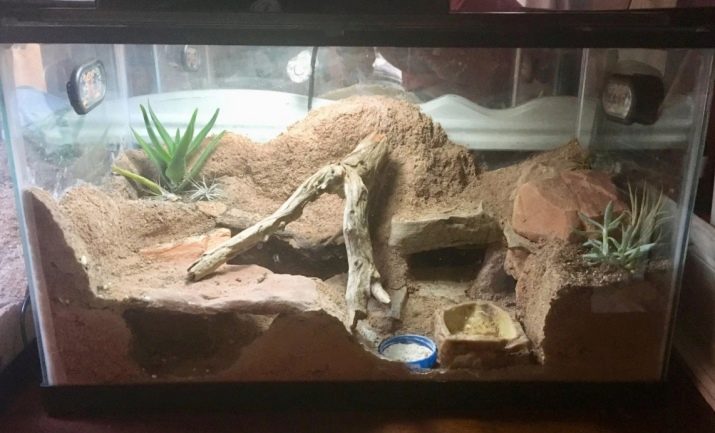
Some inexperienced lizard owners, given the cost of large terrariums, initially purchase smaller models. However, it is important to remember here that this reptile is able to reach its maximum size in just a year. And crampedness in the overwhelming majority of cases will have an extremely negative effect on the health of the pet.
By the way, some experienced breeders advise keeping the described pets one by one. The fact is that there are cases of frequent conflicts that develop into active fights. In addition, there is a factor of dominance of a strong individual over a weak one, as a result of which the latter becomes lethargic, loses its appetite and may even die. This should also be considered when choosing a home for lizards.
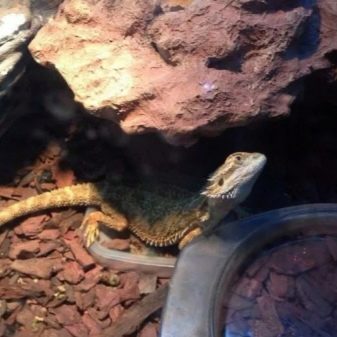
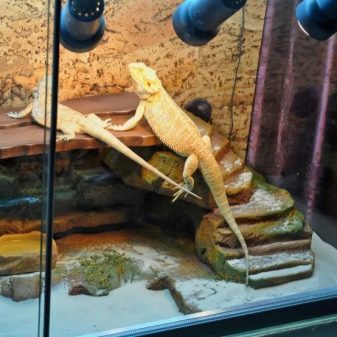
Arrangement
To create favorable and as close to natural living conditions for the bearded agama, it is necessary to properly equip the terrarium. It is important to take into account the high mobility of reptiles. Due to this activity, it is highly recommended to provide sufficient space.
Another important point is access to the inside, which ideally should be from the side. It is important to note that the reptile can perceive the owner's hand dropping from above as a potential danger. You can cover the terrarium from above with a good cover with holes or mesh, which will promote effective ventilation and prevent the accumulation of condensation.
The list of required equipment and accessories is as follows:
- heating lamp;
- ultraviolet source;
- reliable cover;
- thermometer;
- hygrometer;
- priming;
- decorative elements.
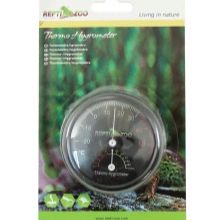
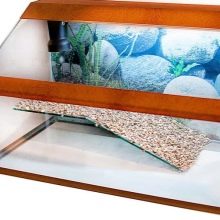
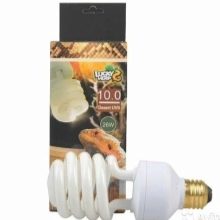
Daytime temperatures should range from 26 to 30 degrees. At night, this indicator drops to 20-25 degrees. It is important to remember that in natural conditions, agamas try to spend most of their daylight hours under the sun. That is why it will be necessary to equip the terrarium with an upper heating, an alternative to which can be the so-called hot stone.
The best option is to install a 75-150 W mirror lamp, taking into account the height of the terrarium. By the way, 75 W devices can be connected in covers, and more powerful ones will need special lamps. It is also worth considering that directly under the heat source, the thermometer should not rise above 38 degrees.
An equally important point is the arrangement of the ultraviolet radiation source. The absence of an appropriate lamp can lead to the development of rickets in the agama, provoked by a deficiency of vitamin D.
When choosing an ultraviolet emitter, you should pay attention to labeling, spectrum characteristics. It is important that it is not tropical or subtropical, but desert.
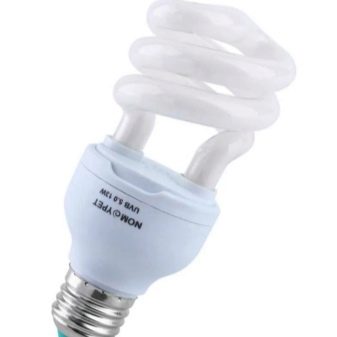
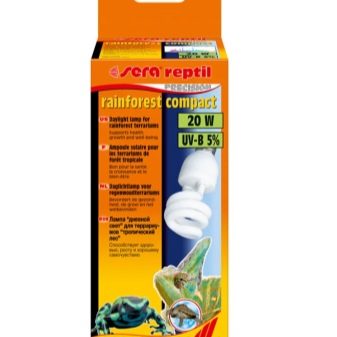
The described reptiles love to bury themselves in the ground, the choice of which should be approached with special attention when arranging a terrarium. Here it is recommended to take into account the following features:
- the minimum layer is 10 cm;
- the most suitable are ready-made substrates that mimic vegetation;
- for young individuals, the use of paper and thick cloth napkins, as well as toilet paper and cellulose rugs is allowed;
- in a terrarium with adult lizards, pebbles (from 1 cm) or sand can be laid on the bottom;
- the presence of gravel, sawdust and stones is unacceptable;
- Agamas often try to eat the soil.

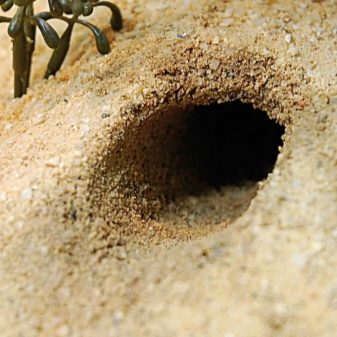
When equipping the house of a bearded agama, it is recommended to take into account that these reptiles practically do not drink, since they have enough moisture contained in the diet (greens and vegetables). However, a drinking bowl with clean and regularly changed water in the terrarium should be mandatory. This is due to the need to maintain the required air humidity and is especially important during the moulting period of the animal. But it is important to remember about the inadmissibility of excessive humidification of the air.
In addition to all of the above, do not forget about decorating the terrarium. The fact is that very often it is not only a living room for the bearded agama, but also an original element of the interior. As a decoration, many people use shelters for lizards of various shapes, driftwood and heating stones. The list of unacceptable things includes living vegetation. It is important to remember that sooner or later the reptile will taste all the contents of its terrarium, and this can have extremely negative consequences.
Lizards are not averse to climbing any obstacle. That is why driftwood and branches without bark will be relevant. They should be commensurate with the inhabitants of the terrarium.
